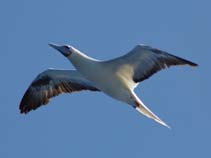Sula sula (Linnaeus, 1766)
Red-footed booby| Native range | All suitable habitat | Point map | Year 2050 |

|
| This map was computer-generated and has not yet been reviewed. |
| Sula sula AquaMaps Data sources: GBIF OBIS |
Classification / Names Common names | Synonyms | CoL | ITIS | WoRMS
Aves | Pelecaniformes | Sulidae
Environment: milieu / climate zone / depth range / distribution range Ecology
Pelagic; depth range 0 - 10 m (Ref. 59262). Subtropical; 22°C - ? (Ref. 84934); 23°N - 24°S, 39°E - 6°W
Distribution Countries | FAO areas | Ecosystems | Occurrences | Introductions
Indo-Pacific, Atlantic Ocean and the Arctic: from Mozambique east to northern Australia and Colombia and Brazil, north to Hawaii and south to Pitcairn Islands.
Length at first maturity / Size / Weight / Age
Maturity: Lm ? range ? - ? cm Max length : 77.0 cm TL male/unsexed; (Ref. 8812); max. published weight: 1.5 kg (Ref. 356)
Short description Morphology
Culmen: 8.47 cm; tarsus: 3.5 cm; wing: 40.7 cm.
Total Length: 66 to 77 cm; Wingspan: 91 to 101 cm (Ref. 8812). Wingspan: 152 cm. The smallest booby (Ref. 91362). Causes of decrease in population is human exploitation, habitat destruction especially in the Western Indian Ocean, predation by rats, and tourism disturbance (84934).
Life cycle and mating behavior Maturity | Reproduction | Spawning | Eggs | Fecundity | Larvae
Main reference
References | Coordinator | Collaborators
Li, X. 1990. (Ref. 78638)
IUCN Red List Status (Ref. 130435: Version 2024-1)
Least Concern (LC) ; Date assessed: 20 February 2020
CITES status (Ref. 108899)
Not Evaluated
CMS (Ref. 116361)
Not Evaluated
Threat to humans
Human uses
| FishSource |
Tools
More information
Trophic Ecology
Ecology
Life cycle
Reproduction
Maturity
Fecundity
Spawning
Eggs
Egg development
Larvae
Larval dynamics
Maturity
Fecundity
Spawning
Eggs
Egg development
Larvae
Larval dynamics
Distribution
Human Related
Aquaculture profile
Stamps, Coins Misc.
Stamps, Coins Misc.
Outreach
References
Internet sources
BHL | BOLD Systems | CISTI | DiscoverLife | FAO(Publication : search) | Fishipedia | GenBank (genome, nucleotide) | GloBI | Gomexsi | Google Books | Google Scholar | Google | PubMed | Tree of Life | Wikipedia (Go, Search) | Zoological Record
Estimates based on models
Price category
(Ref. 80766):
Unknown.



